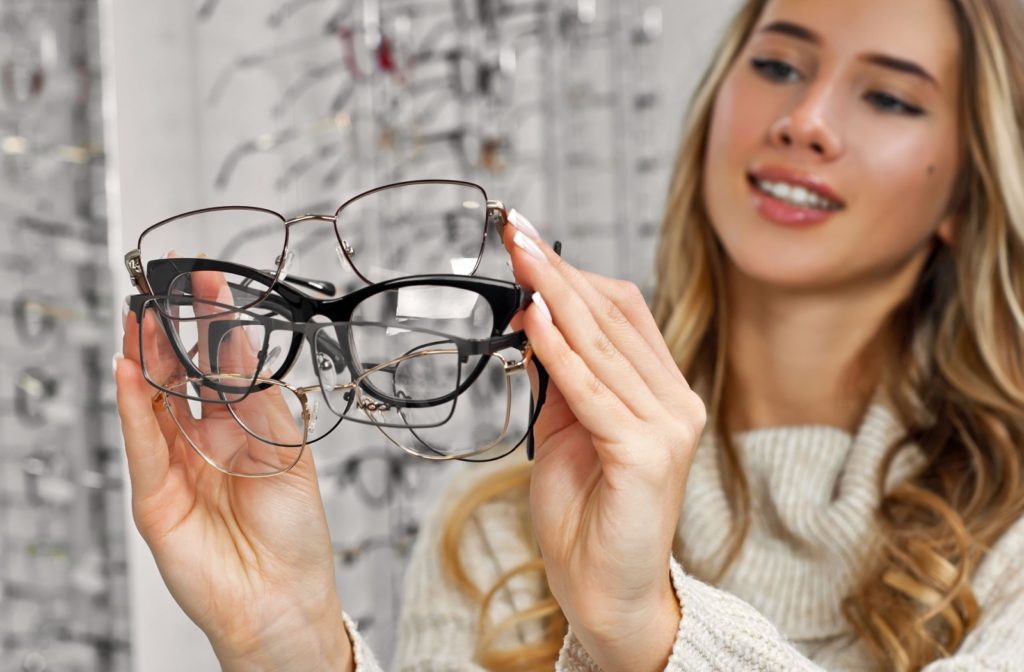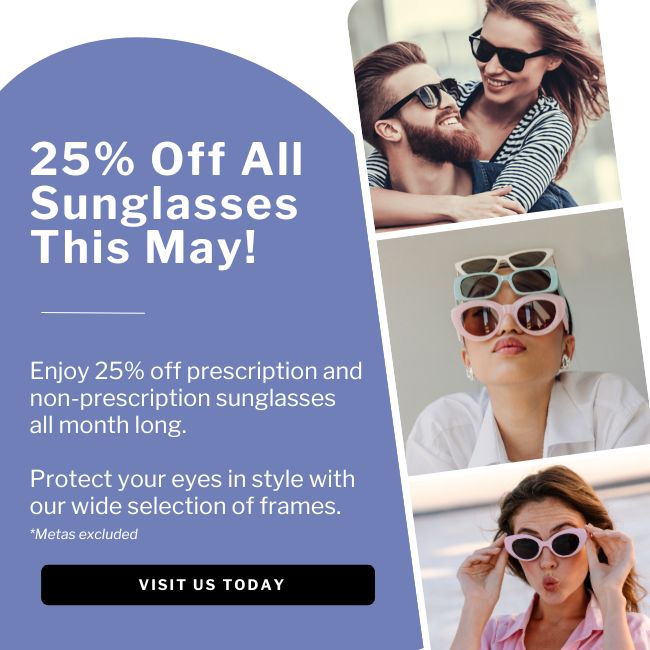Understanding vision conditions like myopia and hyperopia can empower you to better care for your eye health.
Myopia, otherwise known as nearsightedness, and hyperopia, otherwise known as farsightedness, are two types of refractive errors that affect visual acuity. While myopia causes distant objects to appear blurry, hyperopia does the same for objects up close. Let’s delve into these common refractive errors, their causes, symptoms, and treatments, and how Village Optical can help you manage them effectively.
What is Myopia?
Myopia, commonly known as nearsightedness, is a refractive error where distant objects appear blurred, while close objects can be seen clearly. This occurs when the eyeball is too long or the cornea is too curved, causing light rays to focus in front of the retina instead of directly on it.
Symptoms
The most common symptoms of myopia include:
- Blurry vision as objects get farther away
- Close items appear clear
- Headaches
- Eye strain
- Squinting
- Tiredness when driving or playing sports
Some additional symptoms of myopia to watch for in children include:
- Struggling in school
- Short attention span
- Holding things close to their face
Causes
Myopia can be hereditary, often developing during childhood and progressing into adolescence. With myopia, the eyeball can be too long, or oval-shaped, instead of perfectly round. This change in shape causes light that enters the eye to fall in front of the retina, causing blurry images to be sent to the brain.
How to Treat Myopia
- Corrective Lenses: Glasses or contact lenses can effectively compensate for the refractive error, providing clear distance vision.
- Refractive Surgery: Procedures like LASIK can reshape the cornea to correct myopia permanently in suitable candidates.
What is Hyperopia?
Hyperopia, or farsightedness, is the opposite of myopia. Close objects appear blurry, while distant objects can be seen more clearly. This occurs when the eyeball is too short or the cornea is too flat, causing light rays to focus behind the retina instead of directly on it.
Symptoms
The most common symptoms of hyperopia include:
- Blurred, near vision
- Eye strain
- Fatigue/headaches after close work
- Aching or burning eyes
- Poor reading ability
- General muscle tension
- Difficulty in concentrating & maintaining a clear focus on near objects
Causes
Hyperopia can also be hereditary, and may become more noticeable with age as the eye’s natural lens loses flexibility. With hyperopia, the shape of the eyeball is shorter than normal from front to back, causing light that enters the eye to hit the optic nerve too early. This results in blurred images reaching the brain.
How to Treat Hyperopia
- Corrective Lenses: Glasses or contact lenses can correct hyperopia by adjusting the way light enters the eye, improving close-up vision.
- Refractive Surgery: Procedures like LASIK can reshape the cornea to correct hyperopia permanently in suitable candidates.

What Can Eye Exams Diagnose?
Regular eye exams are crucial for detecting various eye conditions and assessing overall eye health. Here are some key aspects eye exams can diagnose:
- Refractive Errors: Myopia, hyperopia, astigmatism, and presbyopia.
- Eye Diseases: Glaucoma, cataracts, diabetic retinopathy, and macular degeneration.
- General Health Issues: High blood pressure, diabetes, and autoimmune diseases that may affect the eyes.
Are There Any Risks with Myopia or Hyperopia?
Risks of Untreated Myopia
- Poor School Experiences: Children with myopia or other vision problems often face challenges in school. They may experience delays in reading and other academic skills, difficulties with social interactions, and lower self-esteem.
- Reduced Quality of Life: Uncorrected nearsightedness can hinder your ability to perform daily tasks and enjoy activities. Clear vision is essential for fully engaging in and appreciating life’s moments.
- Eyestrain: Not addressing nearsightedness can lead to persistent eyestrain and headaches. The constant effort needed to see clearly without proper correction can significantly impact your comfort and productivity.
- Impaired Safety: Vision problems can compromise safety, both for you and those around you. Whether you’re driving a car or operating heavy machinery, clear vision is vital to ensure a safe environment.
- Serious Eye Issues in the Future: Severe nearsightedness (high myopia, over -6.00 prescription) increases the risk of serious eye conditions such as retinal detachment, glaucoma, and cataracts. Proper management and correction are crucial to reducing these risks and maintaining overall eye health.
Risks of Untreated Hyperopia
- Crossed Eyes: Children with farsightedness may develop crossed eyes, a condition that can be effectively treated with specially-designed eyeglasses. These glasses correct part or all of the farsightedness, helping to align the eyes properly.
- Reduced Quality of Life: Living with uncorrected farsightedness can affect your ability to perform tasks effectively. This limited vision can diminish your enjoyment of daily activities, making it harder to fully engage in the things you love.
- Eyestrain: Without proper correction, farsightedness often leads to squinting or straining to see clearly. This constant effort can result in eyestrain and frequent headaches, impacting your overall comfort and well-being.
- Impaired Safety: Safety can be a significant concern when dealing with uncorrected vision problems. Whether driving a car or operating heavy machinery, clear vision is crucial for your safety and the safety of others.
Village Optical: Your Partner in Eye Care
At Village Optical, we prioritize your eye health with personalized care and comprehensive eye exams. Whether you’re dealing with myopia, hyperopia, or any other vision concern, our expert team is here to provide precise prescriptions and guidance on the best corrective options for your needs.
Book Your Appointment Today
Understanding the differences between myopia and hyperopia and knowing how to manage them is essential for maintaining optimal eye health. By recognizing the symptoms and seeking timely professional care at Village Optical, you can enjoy clear, comfortable vision for years to come.
Schedule an appointment today to start your journey towards better eye health.



